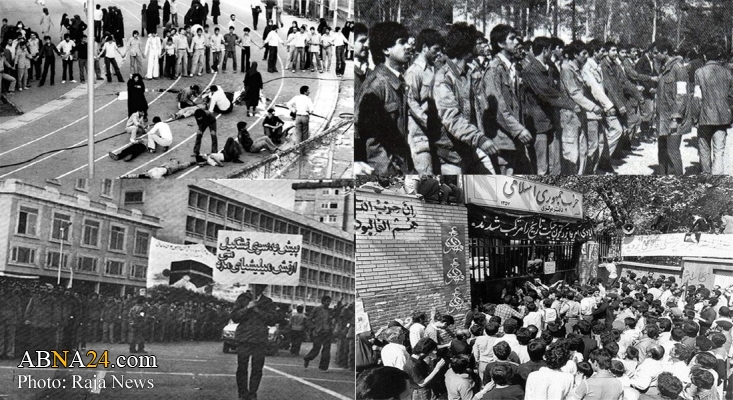AhlulBayt News Agency (ABNA): After the release of political prisoners on the eve of the victory of the revolution, and the subsequent release of Massoud Rajavi (a central member of the Mojahedin-e- Khalq Organization) in January of that year, members of the organization began to define their alignments with other groups. Rajavi's main tactic for preserving the life of the organization was to follow the method of the past and the founders of the organization and use their reputation.
Using thoughtful measures and taking the lead in criticizing the past performance of the organization and the slogans and goals of the early founders, he and his comrades resumed their activities. And In this way, they created a positive image for themselves and made the most of the revolutionary atmosphere for recruitment and reorganization. By formation and reorganizing, the organization published several books in the country by members to praise the organization's casualties. While, the problems caused by the Lack of teaching ideological issues in eliminating its shortcomings and ambiguities were forgotten, and pragmatism and power-seeking grew to the point that prevented the organization from properly analyzing and understanding the existing realities of society. Following this, the organization, from January to February 1979, in order to stabilize its position in the future of the Islamic Revolution, undertook a series of important measures. In fact, in these two months, the centrality of the organization devoted all its efforts to seeking a share in the future of the Islamic Revolution.
One of the most important actions of the organization to achieve this goal was to focus on the forces that the members of the organization and the centrality had worked on in prison.
In a move, the organization's centrality sent these forces as agents across the country and to different cities to be able to implement the organization's plans.
These people had the mission to introduce themselves as revolutionary figures, in other words, the owners of the revolution, through extensive and voluminous propaganda. These forces took part in mass demonstrations across the country at this time; and tried to Display placards, posters, pictures related to the organization, the logo of the organization as well as the sentences of its leaders and pictures of the killed people of the organization in order to gain a place for themselves among the people. In order to be able to acquaint the masses with themselves and to introduce themselves as militant, mujahid and revolutionary forces, if possible. Another important action of the organization at this time includes a large-scale effort of the centrality to gain management of the welcoming ceremony of Imam Khomeini or at least take responsibility in that ceremony.
Therefore, in February 1979 and in the days before the arrival of Imam Khomeini in the country, the Central Committee made extensive efforts to introduce the organization as the largest military force that has the authority to manage the reception of Imam Khomeini and protect the life of Imam; Therefore, they insisted that through this, the organization becomes the main circle around the Imam, so that when he enters the country, Massoud Rajavi and Musa Khiabani will be around the Imam. The effort of the centrality was to make history for the organization by placing themselves in the circle of Imam's entourage so that they could somehow confiscate the revolution and the Imam in their favor. In addition to the efforts of people like martyr Motahari and martyr Beheshti who were in charge, the stance of Imam Khomeini himself, who never even approved of the organization and never recognized them, was very effective in removing the hypocrites from the circle of Imam Khomeini when he arrived.
Therefore, with the efforts of Martyr Boroujerdi's group of seven groups in protecting the life of the Imam and establishing the security of the ceremony, a severe blow was dealt to the goals and plans of the organization.
Storing all kinds of weapons and equipping the organization more and more with weapons at this time were other activities of centrality. At the same time as the revolutionary clashes escalated at this time, the members of the organization began to collect weapons and carry out armed maneuvers. In those days when garrisons, police stations, military bases, SAVAK centers were being occupied, one of the orders of the organization to its forces, which was being seriously pursued, was to loot all kinds of weapons in a very large volume.
The next and calculated move of the organization at this stage was to collect documents of SAVAK and the regime's security organizations. The forces affiliated with the organization were attacking the SAVAK buildings and the regime's security centers, while destroying these centers, collecting documents and transferring them to team houses. The organization did this for two purposes: first, it tried to hide the betrayals of the organization's members in prisons and their cooperation with SAVAK. Their next goal was to collect documents to destroy their opponents and tarnish their position.
Finally, the stance taken by the leaders of the organization in the midst of the revolution gives the impression that they, like the Marxists, believed that the struggle in all societies would eventually leads to the establishment of a democratic system of government. In fact, what the organization was seeking to propagate at this time was the realization of a democratic revolution and the implementation of the principles of socialism in Iranian society. Hence, the organization joined the lines of the revolution to get closer to this goal.
/129
source : Islamic Revolution DC
Sunday
7 February 2021
7:41:10 AM
1112923

After the release of political prisoners on the eve of the victory of the revolution, and the subsequent release of Massoud Rajavi (a central member of the Mojahedin-e- Khalq Organization) in January of that year, members of the organization began to define their alignments with other groups.
